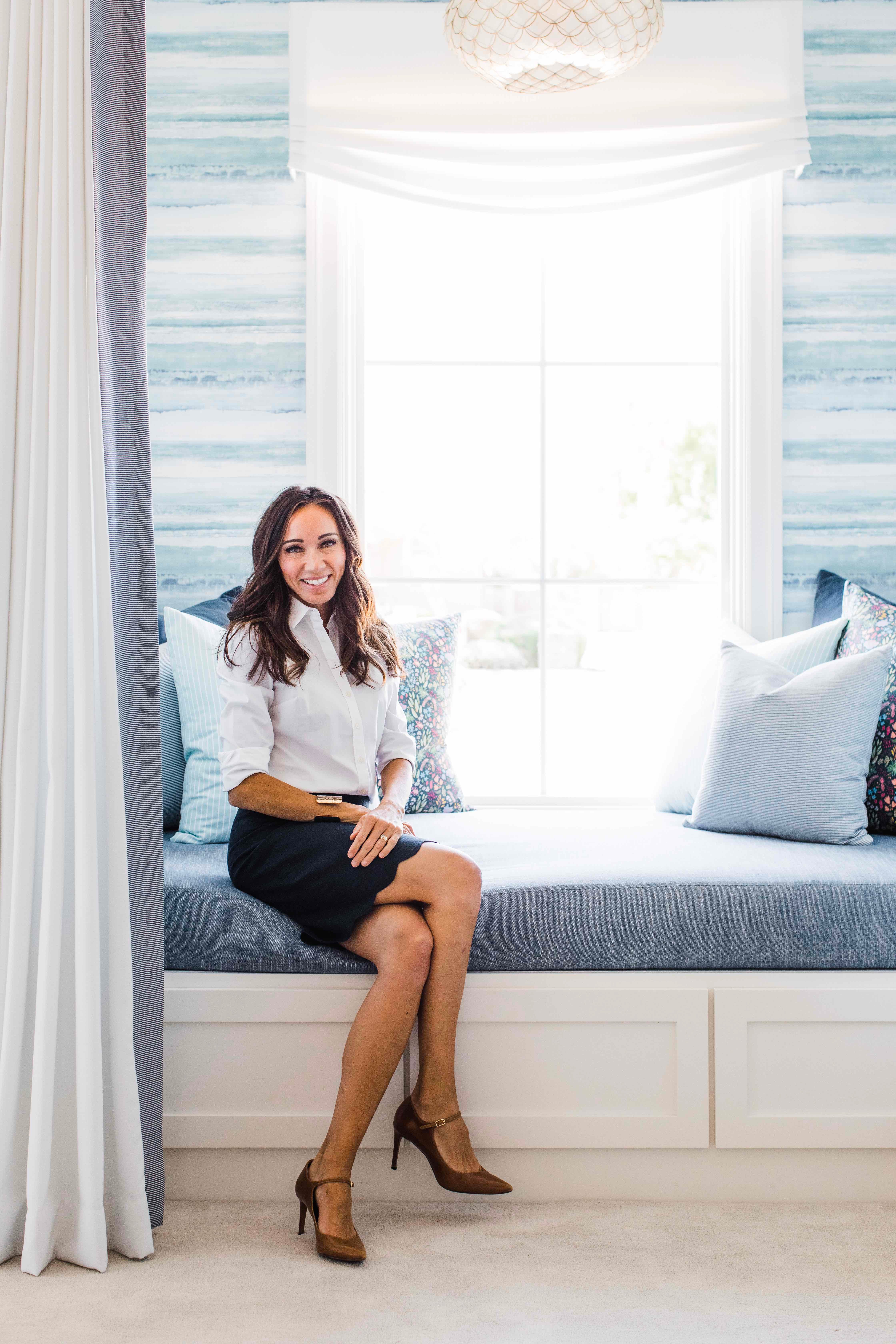The 50 States Project is a yearlong series of candid conversations with interior designers across the country about how they’ve built their businesses. This week, designer Jenny Slingerland, owner of Gilbert, Arizona–based Black Ink Interiors, tells us about her biggest business regret, why she always prepares clients for the worst-case scenario, and how she got over negative self-talk and problematic perfectionism.
What were your earliest memories of being drawn to design?
As a child, I liked arranging things—not necessarily changing the furniture, but arranging the tchotchkes on my dresser. People always say, “Oh, I was moving furniture around as a kid,” and I don’t know that I was doing that. ...
My parents definitely weren’t letting me do that.
Same! But I liked placing my little jewelry box with the figurines—they had a special way of being set. As I got older, I’d arrange my parents’ bookshelves, I guess styling without knowing that I was styling.
When I was a high school senior, I did a mini internship with a design firm for a few days for career class, and I was like, “This is pretty cool.” But when I thought about college, I was like, “There’s always going to be a need for a nurse, even in an economic downturn. An interior designer in an economic downturn? Forget about it.” So I went to school to be a nurse.
I love the human body. I had taken a lot of anatomy and biology classes in high school, and I loved it. I got accepted into the University of Utah’s nursing program—and I hated the prerequisites I had to take so much. But [by the time I thought about switching], I had taken way too many chemistry classes to give up, so I just bit the bullet and finished the degree. I graduated in December, and in January I started in an interior design program—I got my bachelor’s in science, and then got an associate’s degree in design while working nights as a labor delivery nurse. I was full-time both as a nurse and a student.
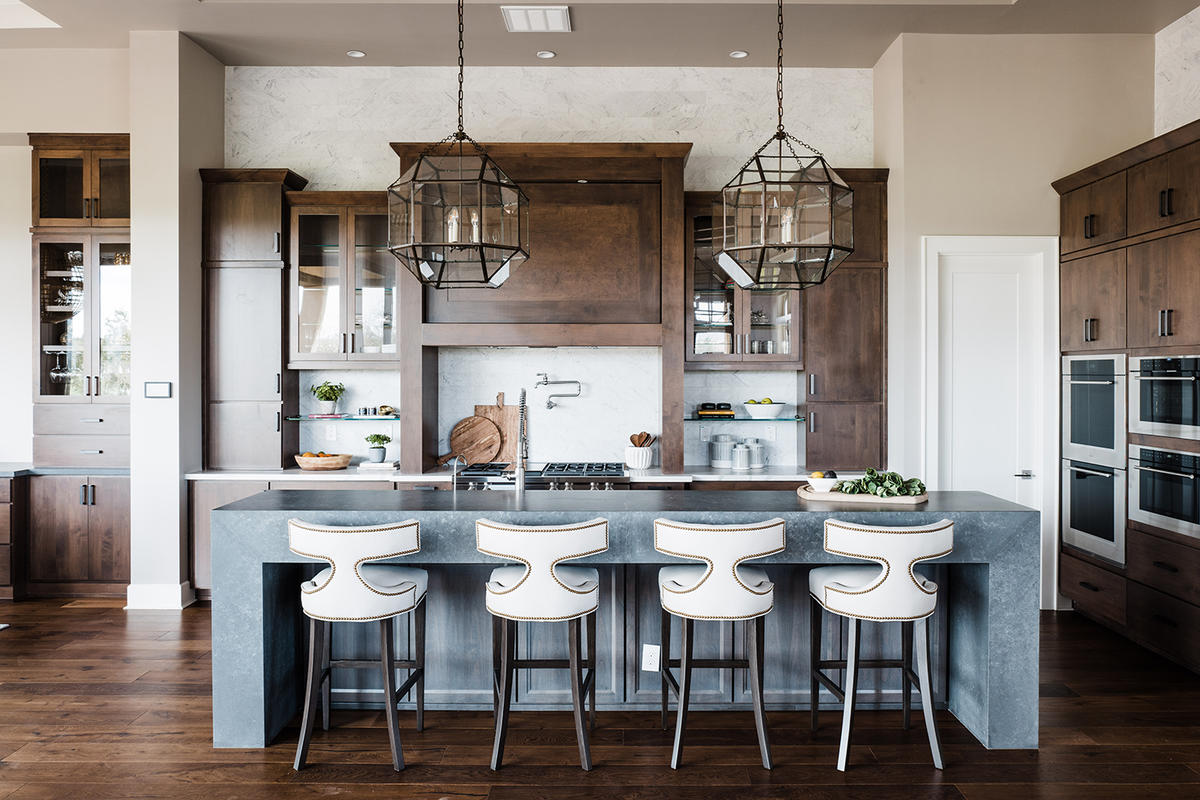
Did you immediately make the pivot to design once you had your degree?
Not quite. I got my degree and then my husband went back to get his MBA, so I worked in the operating room for a couple of years to put him through grad school. Then we moved to Las Vegas for his job, and that’s where I was able to work with a custom home builder in St. George, Utah, and then another in Las Vegas. That job was pivotal in the direction that I’ve taken as a designer because I love construction and I love being on-site.
What was your role at those firms?
It was primarily the finishes—the cabinetry and countertops, hardware, sink, plumbing, tile. And then another designer would do furnishings.
By the time I actually had a client who was like, “Well, now that we’ve built a house, I need furniture,” it was very foreign to me to try to do that side. How do you charge? How do you know what vendors you want to use? What kind of markup do you use—or am I not going to add a markup and just give it to them at cost? A lot of the journey for me has been figuring out: What is the sweet spot?
I think I’ve always known what looks good and what style goes with what home. It wasn’t a question of taste, it was access. I needed to set up all those accounts! I love that we can now take something from working with the architect all the way through the construction, and then plan the furnishings so that when they get the house key from the builder, we’re in there the next day installing furniture, putting sheets on their bed, dishes in the cupboard, and they just walk into their new house and it’s completely ready for them.
How did you know when it was time to go out on your own?
I had my daughter in 2007, and the relationship with the builder I was working with in Vegas was starting to [deteriorate]. I needed to get myself out of that situation, so I started the business not knowing what I was going to do with it—I just started helping a few friends with their homes. My husband’s job moved us around the country, so we went from Las Vegas to New Jersey, which is where I had my second daughter. So now my hands are full and I’m in New Jersey with no family and friends, and don’t know anyone. It’s hard to have a referral-based business and then move. Two years after that, we moved to Oregon, and two years after that, we moved to Arizona. During that time, I embraced that I was a stay-at-home mom. It wasn’t until we had moved to Arizona and lived here for a couple of years that my youngest went into kindergarten and I said, “OK, if I’m going to try this, now’s the time.”
How’d you get your first clients?
I started cold-calling builders. I didn’t know anybody! I just called and was like, “Hey, I’m new in town. Can I have some of your time?” And a couple builders said yes. But it took a year to 18 months to get that phone to ring—and that’s [after] going to networking events, asking people at networking events if they knew of other networking events, joining ASID. I knew that if I could get somebody to give me a chance, I could make my way. I really put myself out there, because I knew people weren’t just going to knock on my door.
My first client was with a custom home-building company—one of the first builders to take a meeting with me. I told him about my history, he told me about his business, and we ended up doing some work together for a charity, and then he brought me some work.
Where did the name of your firm come from?
I had traveled to India a few times to do some humanitarian work, and I fell in love with the jasmine flower. The women there wear it in their hair, so I would buy it every day from the lady that walked down the street, and put it in my hair, too. It was the most beautiful scent, and I came home and planted it all over our house. So I named my first business Jasmine Interiors. But not long after, I got a call and someone asked, “Is Jasmine there?” And I’m like, “Oh, hell no.” I didn’t want anyone thinking my name was Jasmine, but I could not think of a new name. My last name is Slingerland—are you serious? No way. So I was like, “What am I going to do?” I pulled out a Benjamin Moore paint deck, started reading all the colors, and I came across Black Ink and I was like, “I kind of like that.” I asked some friends—I was like, “What do you think of this? Is it weird?” And then I just was like, “No, I think this is it.” So it’s Black Ink Interiors.
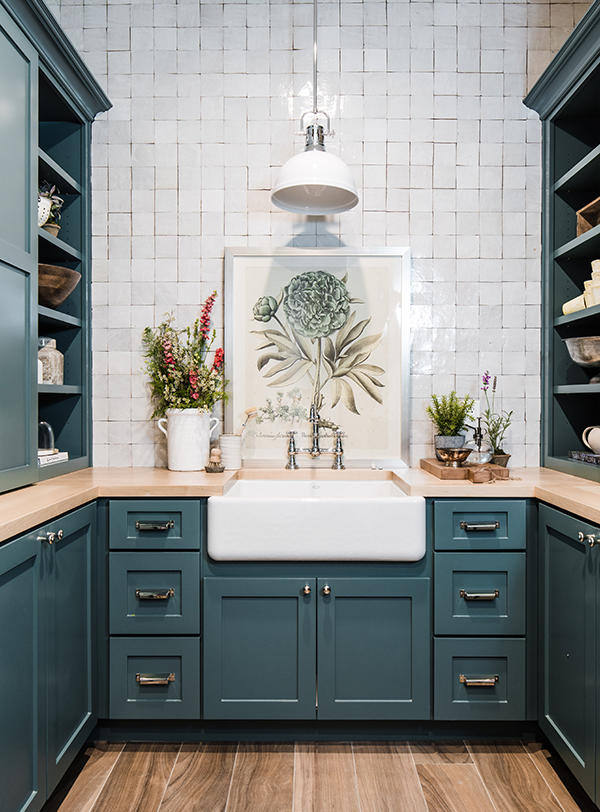
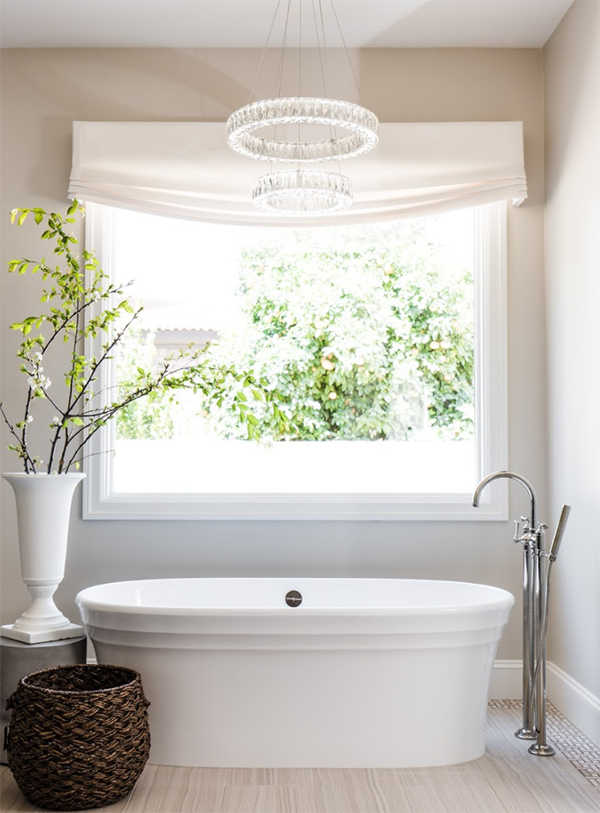
What does your team look like right now? How many projects are you working on and who’s there to support you?
Right now, there’s me and Ben, my husband—we call him my COO, but he’s CFO, COO, HR, anything.
How long has that been the case?
We’re going on two years this spring. That was a big move for us. He worked for Mars, the candy company, and had a really high-paying corporate career, and I convinced him to come work for me for pennies. He’s really taken a lot of the weight off of me, because before that, I was doing it all myself. Then I have two full-time designers, a full-time client service manager, and a part-time procurement specialist to help us place the orders and organize the warehouse when the shipments come in.
How did giving away a lot of the business responsibilities change your experience?
It allowed me more time to not only design, but do more of the networking and continue growing our name and business. It allowed me a second to breathe and say, “OK, here is the next step.” Ben is a smart guy, he has an MBA, and he is able to break it down really clearly and say, “Here’s what we need to set aside for tax. If we hire this person, we need to bring in X amount more money and jobs.” Without him, I wouldn’t have been able to grow to where I am and have my studio, because I would still be working on the business so hard that there would be no room for growth or expansion, or to further the design, really.
What has that growth looked like?
In the past I was terrified to say no to a project, so I would say yes to everything.
And then you’re drowning.
I’m drowning—literally working from 4:30 in the morning to 11:30 at night was my every day for two and a half years, seven days a week. I am now in a position where I’m established enough and have enough in my portfolio to be able to say, “I would rather now take larger projects and have fewer of them than say yes to every project and drown.”
I feel like I have aged 30 years in the last three or four years, but I’m starting to see the payoff, so that is rewarding. We are beginning to get the projects that we really love and can say yes to and get excited about. I now have more time to button up our procedures so that they’re crystal clear to somebody who walks in this door as an intern or employee: This is how we structure our emails, this is how we have a phone call, here is how we put together a design presentation. We are almost there, but one thing I regret is jumping in and getting so busy and hiring without having the details on the back end buttoned up. So now it’s like, OK, foot on the brakes. Let’s take a second.
How many projects are you working on?
We have 16 active clients right now—and this is considered downtime.
How hands-on are you with each client?
Totally hands-on. For every project, it’s me and a lead designer. I mean, at some point or another, everyone is going to touch everyone else’s project whether they like it or not if one person’s load is heavy while somebody else is a little slow—but there’s a point person and we ask our clients to reach out to them first. They can copy me on the email if they want, but address it to the lead designer, who will answer it or come to me for an answer.
At one point, we had 23 clients and it was so hard for me to keep all of that straight. By having that lead designer, they may not know the answer but they can say, “Let me check with Jenny and get back to you on that.”
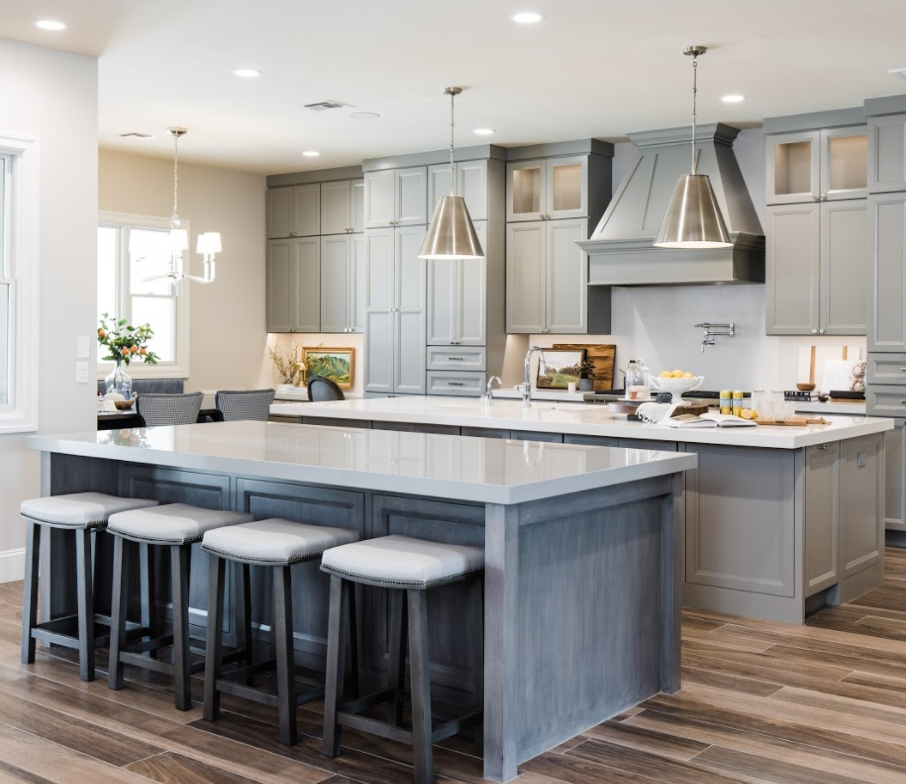
What’s the biggest thing you wish you had known from the start?
How to stand up for myself and say no to jobs or clients that aren’t a good fit. And learning to stand in my space. In other words, I have a process that I know works for us and I’ve had clients who will be like, “Well, I’m not going to do your X, Y, Z. I’m only going to do A, B, C.” Now I can say, “If you aren’t willing to do [the process] the way we have it structured, you are not a good fit for us, because I know that this is going to give you the best outcome and it’s going to make us both successful.”
Where do clients want to go rogue?
They’ll want to save wherever they can. They won’t want to pay to do an elevation of the shower. Well, how is the tile installer going to know how to lay the tile? How are they going to know how thick the grout is? How are they going to know where the niche is for your shampoo? You’re fighting me on the charge for one elevation that will take us an hour [in exchange for] five hours of calls, emails, site visits from a plumber, an electrician, and a general contractor—all because you didn’t want to pay for us to elevate that for you.
We’ll also get the pushback like, “I don’t want to pay for [an item] to go to a receiving warehouse, it can just be shipped to my house.” Well, a lot of the vendors that we use don’t ship to residences. Or what happens when you’re at work and we get a call saying the delivery has arrived? You said you would handle it, but you called me in a panic and I have to stop what I’m doing to run to your house to get the delivery from Restoration Hardware. Every time I have gone outside of our best process for the job, it’s come back to haunt me.
Tell me about the design scene in Arizona.
We have an amazing group of supportive designers in Arizona—here in Phoenix, in Scottsdale. The community shares information, vendors, even samples. I just had a designer today say, “Hey, I’m ordering something from this vendor that you use, can I borrow your sample?” Totally! They sent a messenger, I had it bagged up and sent down to their office. We also share what we charge—if we can all learn from each other, it benefits all of us.
I think what’s going to save our industry is the people who are willing to give the information, to be willing to come to you and talk, to not be afraid to put yourself out there. When designers have each other’s backs, if people push back or say, “I’m going to find someone to do it cheaper,” you can say, “Well, I know the people that I would recommend are just as expensive as me, so good luck to you.”
Housing prices are skyrocketing here right now. A lot of people from California are coming for political or cost-of-living reasons, or people from the Midwest who are tired of winter, so a house will be on the market for 24 hours and have 30 people walk through and make 18 offers. It’s crazy!
How do clients find you?
Social media, referrals, and then builders with whom we’ve developed a relationship. I think it’s important as a designer to do everything you can to make a builder’s life easy, because they will return that favor tenfold. You have to deliver what you say you’re going to deliver in the time that you say you’re going to do it, because if you mess that up, they’re not going to call you again. They don’t want to experience that or have their clients experience that again. So I think [referrals are] a nice way of saying, “You’re doing a pretty good job, I’m willing to put you on another project.”
Has the way you approach billing changed over time?
Yes. Back in the day when I was just working with friends, I’d be like, “This is on sale—I’m just going to order it, you can pay me back.” I have learned that I am not a bank. I no longer order anything until somebody pays me for it. I make sure that they’ve approved it and we have it in writing, because often they’ll be like, “I never approved that.” I’m able to say, “Well, actually, we’ve got your initials here—so you did.” But it is difficult for me, I don’t know why, but it has sometimes been hard to have the money conversation. It’s been a journey for me to be able to stand in my space and say, “This is how we charge. This is how we price our furnishings. If this doesn’t work for you or you feel like you’re going to get better value from somebody else, then best of luck to you. No hard feelings, but I know what I’m worth and what I need to cover my bills and time.”
What makes you uneasy about having that conversation?
I think that’s the biggest struggle that designers are facing right now: people who say, “What discount are you giving me?” I understand where they’re coming from, but at the same time, you don’t walk into Mastro’s Steakhouse and say, “What did you pay for this steak? What’s your markup? What discount are you going to give me?” No. They’re cooking it a certain way. They pick a certain grade of meat to get it to your plate to taste the way it does that you want to pay whatever exorbitant amount of money to eat it. And really, it’s the process, the service, the experience that you’re paying for.
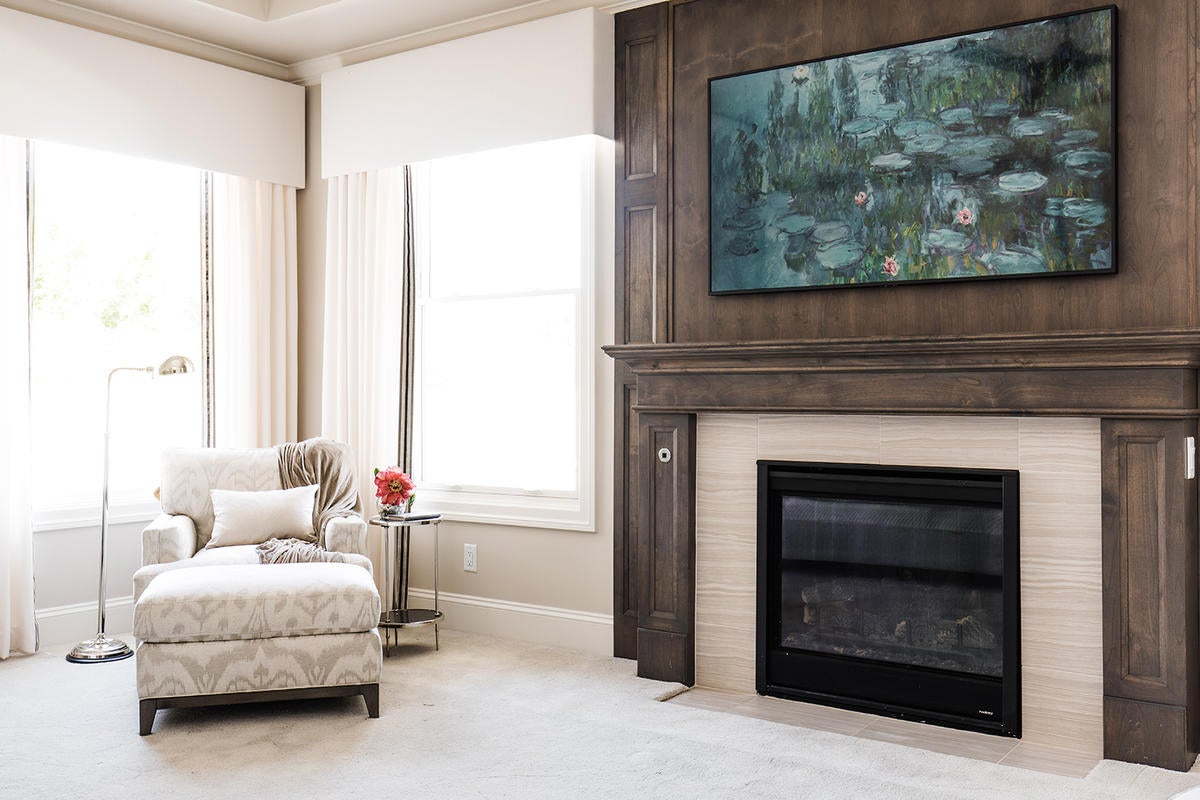
I know you had an install yesterday. Has COVID changed the way you have to approach that?
COVID has changed the conversation early on. I always try to warn my clients upfront if there’s going to be something that disrupts our normal process. Typically, [pre-COVID] our lead times on furnishings were six to eight weeks. Now they’re 10 to 16 weeks. So if you need something faster, you might be better off going to Pottery Barn or Restoration Hardware. So I’m upfront and say, “This is what our deliverables look like for our full-service design.” That said, I’m finding that even retail vendors have long lead times these days, so they might not be any faster than us after all. The message now is just: It’s going to take a lot longer.
How do you work around that?
If the majority of the home or pieces that we need are in by one date and we have a couple of stragglers, we do two installs. It doesn’t make sense for us to have three-quarters of the house sitting in a warehouse while we wait for 10 more pieces to come two months later. I deliver the majority of what you have, then wait for that second round to come together so we’re only in there twice. That’s what we were doing yesterday—a second install with all of the finishing touches.
If you are upfront and give worst-case scenarios in the beginning of this project, you are in a better position so that when things go wrong, they can’t say, “You said six to eight weeks.” They’re ready for it—you’ve already warned them.
Under normal circumstances, though, you’d be going for the big reveal?
I think the big reveal is important for a couple of reasons. If you spread out the install, the client often comes in and sees a new sofa on their old rug with their old lamp and is like, “This is too big,” or, “I hate the color.” And of course it is, because they aren’t seeing the whole picture as you had planned it. But when they come in and are able to see everything together the way that you intended it, the vision comes to life.
We always tell our clients, “We don’t want you to come here over the next couple of days, we want it to be a true reveal.” Sometimes it takes time. Maybe we style the coffee table and we’re like, “Something’s not right.” You switch something out. If it’s the way that we know it looks best when they come in, that’s when you get the most transformative experience.
How are you handling the COVID delays?
Right now, it’s important to let them know upfront the limitations that we are facing industry-wide. If you can’t take their project right now, be honest and say, “I would love to work with you, but I want to give you my best service and I have to wrap up these projects. If you would like to work with us, it’s worth it to wait two months until my schedule frees up so I can give your project my full attention. If I took on your project right now, it would be a disservice to the clients I have and a disservice to you.” That’s my advice.
Something will always go wrong. Something’s going to come in damaged, so just let them know that you’ll handle it. That’s why you’re paying me—to take care of this. If you have a problem, always have a solution before you make the call. Don’t call them and say, “Your sofa’s not coming for three months.” Say, “Your sofa was delayed. It’s going to be three months from now. What we have in the interim is I’ve arranged with a staging company to borrow one of their sofas so that you don’t have to be without a sofa.” Always have a solution when you have to give some bad news.
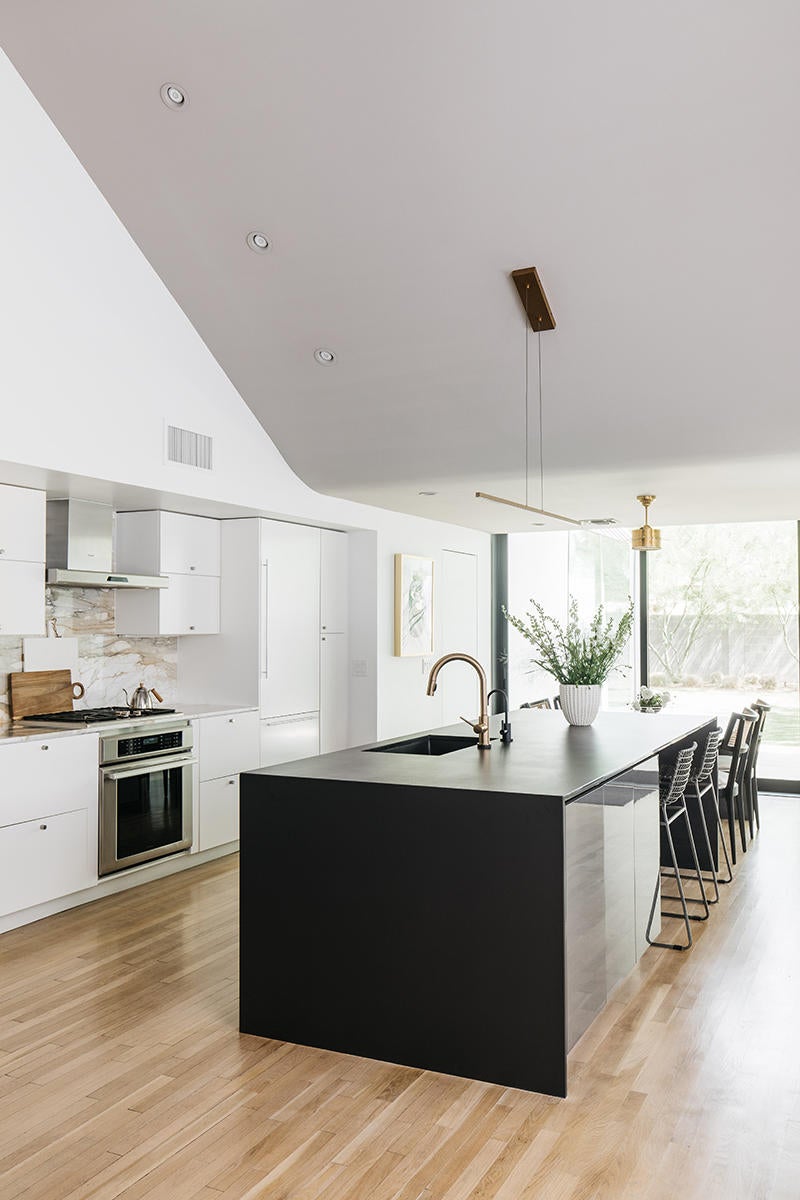
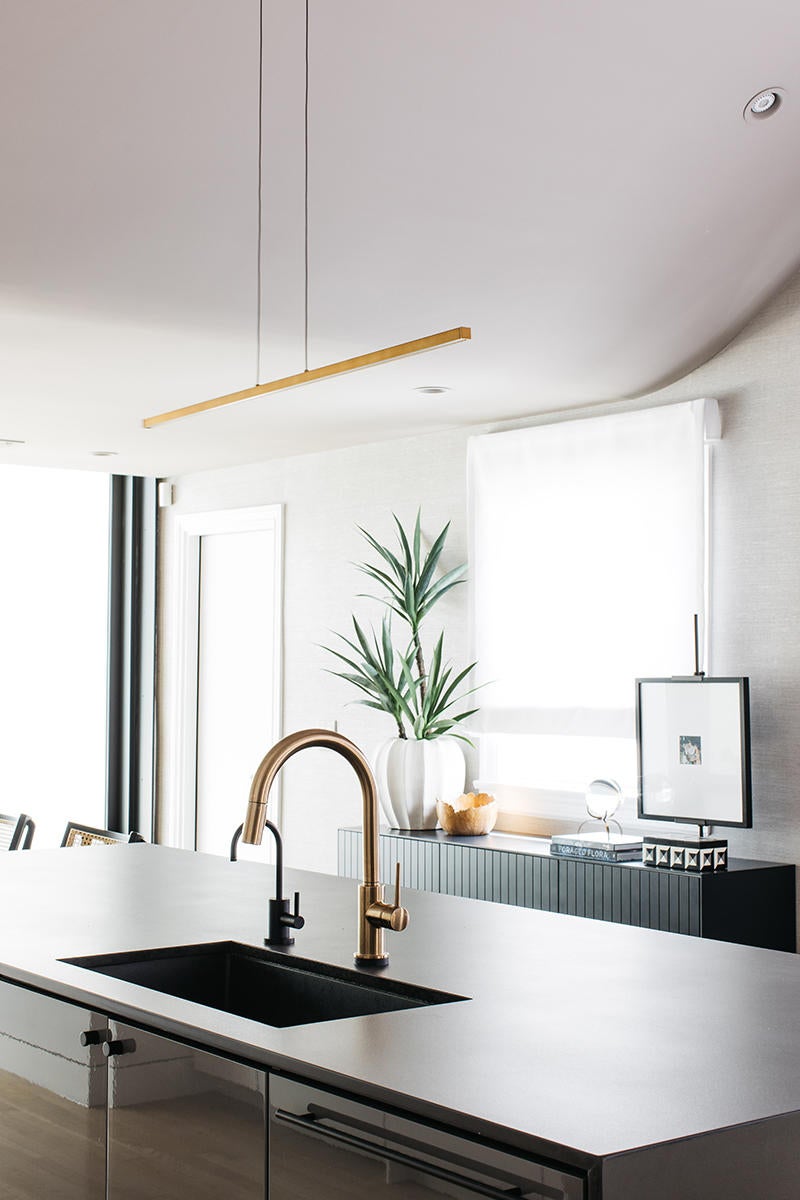
You talked about “standing in your space” earlier. Was there a moment that gave you the confidence to do that?
I think it has been witnessing projects going sideways when I went outside of my normal process. You just reach that breaking point one day where you’re done being walked on by clients and you mean it—and I think that comes from having processes and procedures in place for yourself and for your team to follow. If you have that, you know what your nonnegotiables are. We have a 10-step program that’s basically from the start of a project to our final walk-through and client lunch that we do. And because I have those, I can say to the client, “Here are these steps, and let me tell you why I have the steps.” If you’re just willy-nilly saying, “Well, I don’t really want to work that way, but I guess I can this time,” you don’t have a leg to stand on. But you have to have that process so that you can be very clear in what you will and won’t do, I think, to be able to stand in your space.
What do your conversations about money look like with clients as a result of owning that process?
The money that I used to fear talking about is now one of the very first things I talk about. I’m upfront now and just say, “This is our fee.” We’re at a point now where we can explain that we have a minimum furniture budget to work with us.
The designer who gets in trouble is the one who isn’t clear on what the cost is and what the deliverables are—then someone is going to lose. If you aren’t upfront and later present them with the bill and they’re like, “What do you mean it took five hours to pick a sofa? I’m not paying you five hours for a sofa.” So you say, “OK, then let’s make it three hours.” You whittle down your time—and now you’re literally wasting time that you worked on the project, but you’re taking it down to a point where you’re unhappy, but the client’s happy. Or vice versa, maybe they pay you but are upset about it, and then they might not tell their friends about you.
If the deliverables aren’t clear, then there’s going to be a miscommunication and people will be like, “Well, I thought this was included in your fees.” No, it isn’t. All right, well now I know next time that I need to be clear so that I don’t have to do 10 more hours of work because I feel bad that they thought it was included. I’m not getting paid for it, but they’re expecting it so I have to do it. Literally every time I have a project, there’s something we add to the contract.
A lesson learned from the previous one.
Every time. Yes. It’s like, oh, didn’t see that. But it’s getting to be smaller issues and more minute details because the bigger problems we’ve already worked through. For designers who are starting out, there will be projects that you want to take that maybe you take for less pay. Those first projects that I got, I did at a reduced rate because it was like, “Thanks for taking a chance on me. I think we could have a history of working together.” It’s OK at times to take less money to get your name out there, to work with a certain builder or architect. I’ll do the same with furniture—if this house is going to be a really good project for my portfolio, I may take little or no markup knowing it will benefit me on the back end to photograph that finished project. I still do that. There are things that you can look at and not be a hard rule, per se, because you benefit in another way. Whatever that looks like, you are still benefiting and it’s worth the $500 markup you would have made on one dining table.
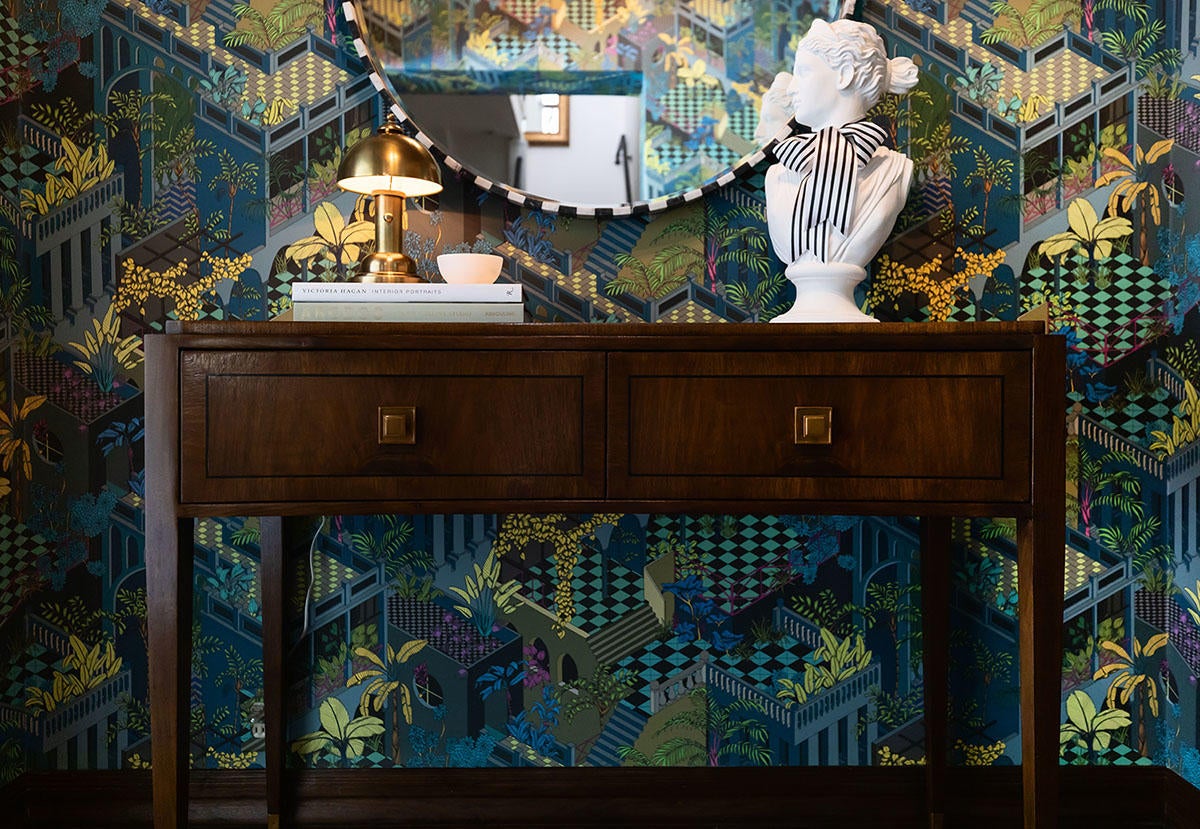
You’ve experienced some pretty massive growth in the past year or so—what have you learned along the way?
I’m learning to have more grace for myself because I want to be the perfect mom, the perfect wife, the perfect boss, the perfect business owner, the perfect designer. I have tried to be those things and you are just setting yourself up for failure. When you have that work-life balance, some days I’m not going to make it to my daughter’s school performance. There will be days when I take off early for work and grab the kids from school and take them to ice cream. I do what I can to still be a good wife, a good mom, a good boss—do all the things, but not beat myself up the way I used to, because it’s not good.
There’s this mom guilt that you add onto all your other issues and it’s just too much. So in the last six months or so, I’ve really tried to give myself more grace, saying, “I’m doing the best I can in all the areas. I’m not going to be the best at them all, but I’m going to do my best.”
That’s amazing.
I don’t know, ask my kids.
No, I mean it!
Thank you. It’s hard and it’s taken four solid years of beating myself up and [having] negative [internal] talk: You’re a horrible mom, you’re a horrible wife, you’re a horrible boss. You’re horrible at all the things—instead of just, “I’m doing what I can to support my family and three employees’ families and still be a good mom and play games when I get home and I’m exhausted.” Just do what you can do.
My daughters have seen I’m up before anyone in the morning. I go to bed later than anyone usually. I know it sank in when my daughter, a month ago, said, “Mom, you have a great work ethic.” It meant so much. I was like, “Oh, you noticed.” And Ben is always very good about saying, “Hey guys, just so you know, we’re able to take this trip to California and go to the beach because mom works really hard.” Because even though it’s his hard work, too, he knows that I need a victory in my corner.
What are you looking forward to this year?
Right now, my office is 45 minutes from my home—that’s without traffic, door to door. There have been times before COVID when we would have hour-and-15-minute drives each way, and then the time to get ready in the morning. So that’s two and a half hours of my day in a car when I can be with my family. My lease is up in May, and I’ve decided I’m not going to renew and we’re going to work from home. We’re going to look for a new home where we can have a second structure—we’ve been looking and we’re still struggling with that, but we’re going to take the business back home so that I can be there in the morning and when they get home from school. They’re at that age where I’m recognizing, yes, I was there with them until they were in kindergarten and that’s wonderful, but they don’t remember. These are the years where it’s like, “I need mom.” And for me, I just want to be there.
As horrible as 2020 and COVID have been, I think we all learned a lot of lessons—and one of the benefits has been spending more time with family and being around each other more. I appreciated that and recognized that I needed that more in my life. While I may have come to that conclusion on my own eventually, I think COVID definitely helped accelerate that.
Is there anything at the showroom that you’ll end up giving up as a result? What was so meaningful about that physical space?
When I got it, I think it meant that I had kind of arrived. It’s like, “I’m here, I’m legitimate and I have a studio, people can come in here.” But we still do a lot of our meetings at clients’ homes or at builders’ offices. I don’t for one second worry about where we’re going to do our meetings now, because 90 percent of the time it’s not in the office anyways. But in the beginning I felt like it legitimized my work.
Will your team then come to your house, or is everyone going to work from their own home?
They’ll be here, in our home. We’re going to do some rearranging of some rooms. Ben and I already have our offices, mine with a couple of desks that we work out of sometimes. So we’re just going to do some rearranging until we find a house.
To learn more about Jenny Slingerland, visit her website or find her on Instagram.
Homepage image: Jenny Slingerland | Courtesy of Black Ink Interiors
















